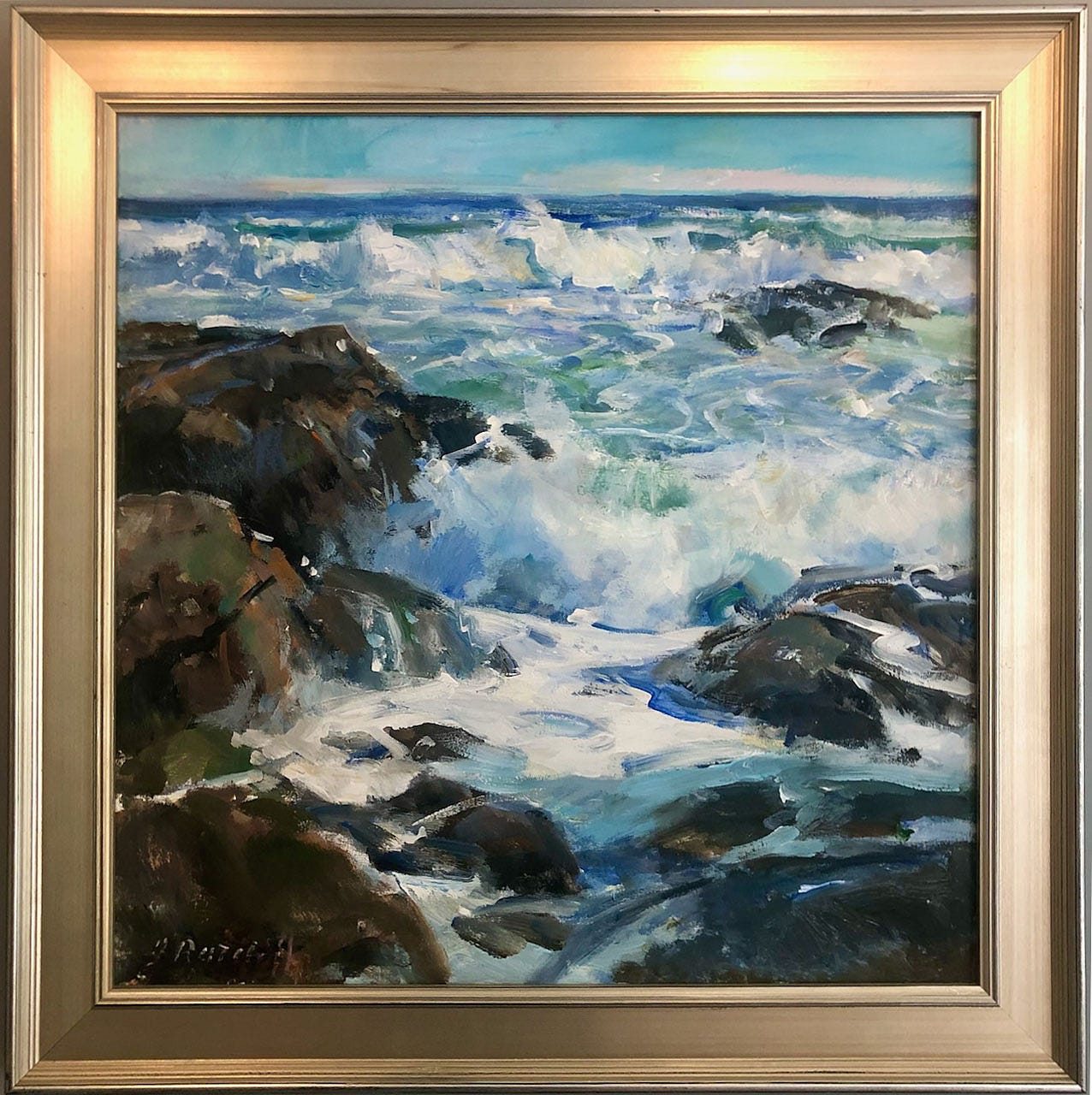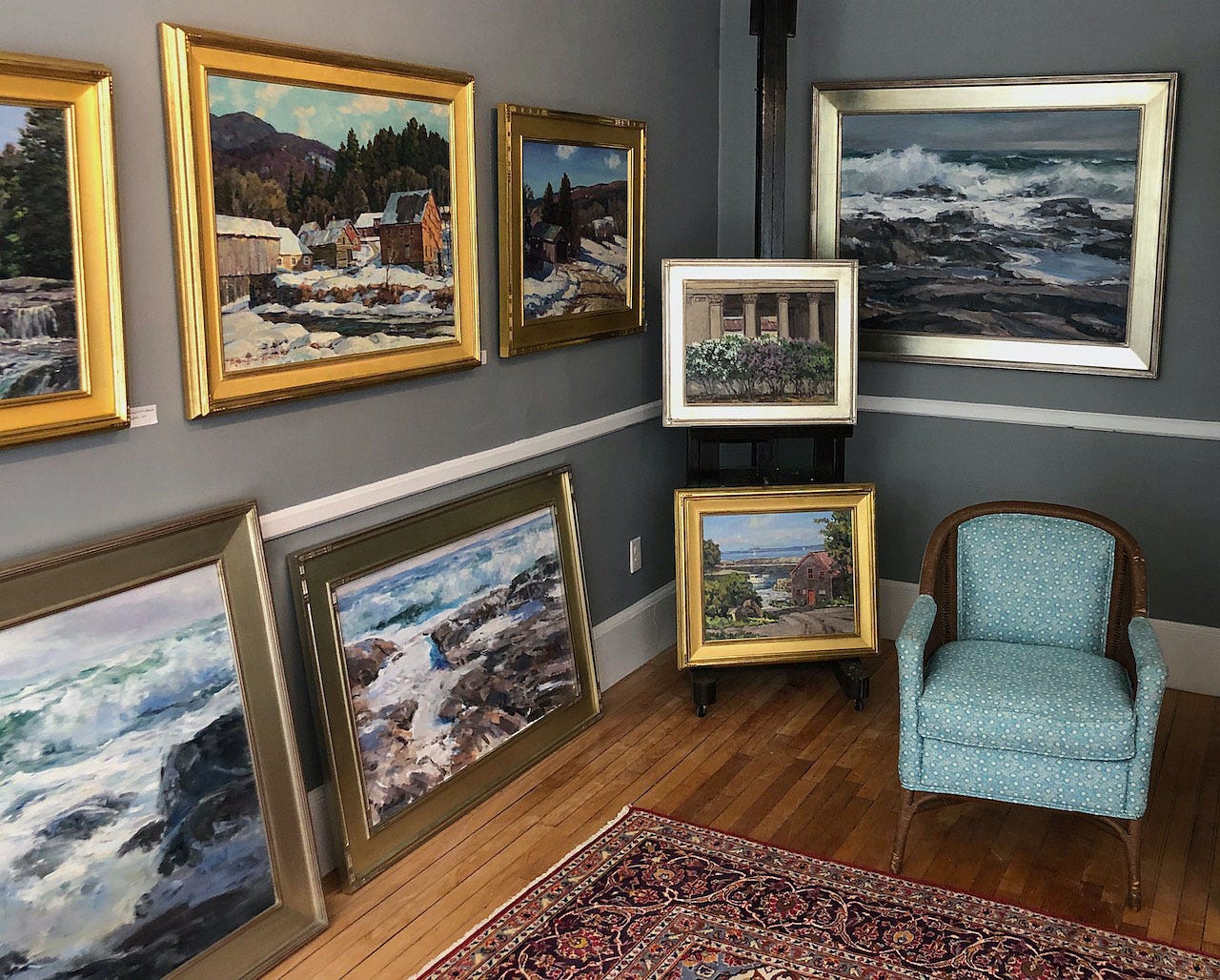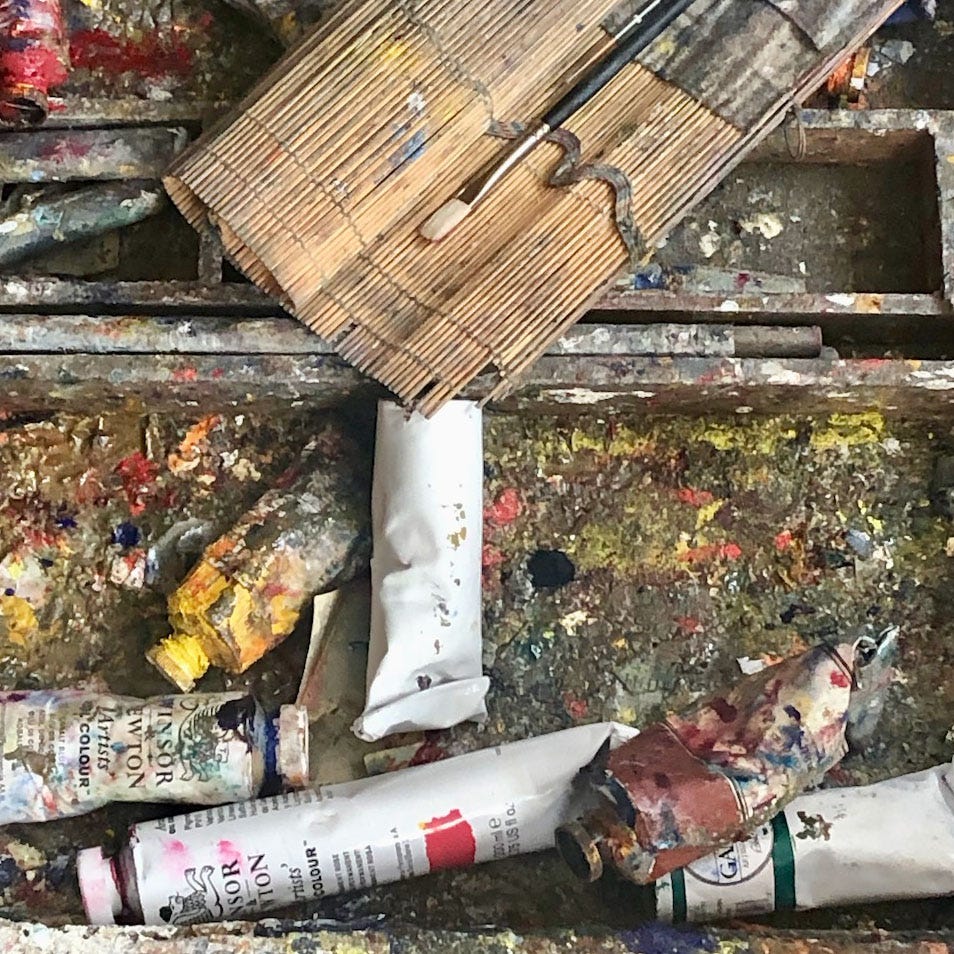Dale Ratcliff and Stapleton Kearns
The new gallery, why he gives away art lessons, the power of a great high school art teacher, and plein air painting inspiration
Hello and welcome to the first issue of Palate & Palette, which combines my interest in people who make great art and food. I’m Amy and I’m glad you are here! Each week I’ll be talking to artists and food people I admire and sharing our conversations.
I recently had the distinct pleasure of spending time with painters Stapleton Kearns and Dale Ratcliff at their brand-new Stapleton Kearns Gallery in Rockport, MA.
Kearns and Ratcliff have seemingly endless stories to tell about how they learned their craft, what it’s like being part of an artist community with a rich history, and what inspires them to paint today. There’s also the story about them: longtime friends with a deep respect for each other’s art, a passion for plein air painting, and their plans to get married later this year.
Talking to them was like being with long-time friends and partners, except in some of Ratcliff’s stories, “we” and “us” referred to her and her late husband, the painter Charles Movalli, as Kearns was quick to point out. He jokingly called himself the “after-market replacement part” as her soon-to-be husband who has deep respect for her rich life history with Movalli. Ratcliff credits Kearns for bringing her back to painting, and they have entered this new chapter together with enthusiasm for opening the gallery, getting hitched, going on painting trips, and seeing Dead & Company—the latest version of the band the Grateful Dead—whenever they can.
Tell me about you and the new gallery.
KEARNS: Dale was widowed six years ago in 2016. I was divorced a couple years before that. We’ve known one another a long time—the Rockport art world is not huge. We threw our lot in together three or four years ago.
This gallery is the Stapleton Kearns Gallery. I’ve had galleries for years, and Dale has art here too. It’s the fourth gallery I’ve had in Rockport; I opened my first in 1983. I did galleries here in the ’80s and ’90s, and 18 years ago I moved to Derry, New Hampshire. I opened this gallery because I realized I felt most effective, best knew what I ought to be doing, and felt the most purpose when I ran a gallery.
RATCLIFF: The art gallery scene is more familiar to Stape. I’ve shown in a number of galleries but never managed one before. My work has been displayed all over New England, from the top to the bottom of Maine, and of course the Rockport and North Shore Arts associations and also in West Virginia at Walls Fine Art.
It feels like Stape and I have been together a long time. He helped me with the Rockport Art Association retrospective of Charles Movalli, including writing for the exhibition catalog.
What was putting together the retrospective Movalli shows like and what challenges and decisions did you face?
RATCLIFF: The first was at the Cape Ann Museum, and many of those paintings were borrowed from private collections and probably half were those I had myself. We had just under 50 paintings in that show.
The Cape Ann Museum thought of Charlie as a regional Cape Ann painter who did harbors and boats, but Charlie was doing workshops all over the country and in Europe, and he painted everything—figurative to still life—so I changed the thrust of the North Shore exhibit to show everything he could do.
KEARNS: He was also the best-known artist writer for traditional painting in America. He was the lord of American Artist magazine for 20 years, and he was also a contributing editor. People bought the magazine to read one of the 80 articles he wrote.
RATCLIFF: The title of his series of articles was “Conversations with Charles Movalli.” I just recently published the first of what I hope is several volumes of his conversations—15 of them with Cape Ann painters—and I have 5,000 copies ready to distribute.
KEARNS: Charles’ work is handled by Gallery Montanaro, and he does a great job. But here, we want to promote our own art, so the gallery’s focus is my art and some of Dale’s.
RATCLIFF: Stape was instrumental with the Rockport show [which had 150 paintings]. I had curated the first two shows and framed everything myself. I had to. But I was getting weary. I was obsessed with honoring his legacy and it was my way of dealing with the grief that I felt. We had been together over 30 years.
KEARNS: I’m merely an aftermarket replacement part—it’s a lot like the original part in some ways …it works pretty well but it’s not the original part.
RATCLIFF: I think he’s awfully nice. Stape is responsible for giving me back the art life that I had, where the focus was on a couple, and now we’re a couple. I have a renewed interest in my own creativity.
KEARNS: You fell off the beat for a while. Charlie died and you were grief stricken and you didn’t work, and you had put a lot of effort into his career. It isn’t like I’ve done something. Now you’re back into doing what you do.
RATCLIFF: Your love of what you do and what we create on trips [brought me back]. I studied the work of marine painter Frederick Waugh—always loved his work. Stape and I went to a place near Bailey Island in Maine where Waugh painted and did the research on his rock formations. We went there twice and painted. This is significant because all the places we’ve been painting have been uplifting and have been springboards for more adventures. He’s given me a future of painting to look forward to.
If you could magically transport yourself to any place and time to paint, where would you want to be?
KEARNS: I went to Kostroma, Russia, to paint in 2018 or 2019. It was about 7 or 8 hours west of Moscow. I was painting with a bunch of Russians who were very good painters. Kostroma was another world. We were out in the countryside in birch forests and log cabin villages. The roads weren’t put in with bulldozers, but were the worn-down paths of cattle and horses that went over the hills to form a channel through them.
If I could paint anywhere historically, I would like to paint the docks in Gloucester in 1920—or maybe 1915—before they were lost to urban renewal. I know the old paintings that were made there, and they were fabulous.
RATCLIFF: I enjoy painting the sea more than anything else. I loved trips to England, Cornwall, and Devon. My second love, which you are not going to believe, is horses. I’ve owned show horses my whole life and shown them and driven them. I had many painting commissions featuring children with their horses, and horse heads. It’s what got me through the 1970s. I loved going to the shows and photographing and doing scenes at the shows. I went out west on trail rides and was excited about western culture and western painters and cowboy painters like Remington. We [Ratcliff and Movalli] split the trips between horses and culture. We would go to museums and see the landscapes and then go see the horses.
I would also like to revisit Glacier National Park. I also like sitting on the back shore of Cape Ann and painting 8 x 10 studies like you see here [points to shelves of ocean paintings].
Who would you want to have painting alongside you at that time?
KEARNS: There are so many. Emile Gruppe, but then I’d have to make it 1925 or 1928. I would like to have painted with George Inness in the 1880s and 1890s in New Jersey.
Dale, with your ocean paintings you are creating a moment in time, but you are also showing so much movement and emotion. How are you doing that?
RATCLIFF: That’s it. Rhythm and motion—getting the water to move, and having you picture the rest of the swell beyond the frame so that the painting becomes part of nature. It’s always a design challenge to create an effect in a limited space, but have the viewer’s imagination carry it into the ocean.
I studied with a great marine painter, my high school art teacher Howard Curtis. I learned a lot about Frederick Waugh from Howard Curtis. Even as a high school student I painted the ocean and brought Howard the paintings after school to critique. He encouraged me to pursue art as a lifelong career, which it has been. He died in the ’80s, and I wonder if he knows I’m still painting the ocean.
What’s the best advice you received as a painter?
RATCLIFF: Devote a lot of your time to teaching. When you teach, you solve so many problems for your students that it becomes an educational journey for you and your development. You have to come up with solutions on the spot for your students, and when you are out in the field you can tap into that.
Malcolm Gladwell says you need to put in 10,000 hours to get good at something, and that’s how long it took the Beatles to get good. Does that apply to art?
KEARNS: Painting takes longer.
Speaking of the Beatles, what concerts stand out in your memory?
RATCLIFF: We are big rock fans. We go to Dead and Company concerts. The Boulder Dead shows at Folsom Fields were fabulous.
KEARNS: I’ve been going to 4 or 5 concerts a year since the late ’60s. I’ve seen hundreds of concerts. I saw Spirit in Minneapolis in about ’69 and they were fabulous. The second Dead show at Great Woods was epic.
Who is an artist, writer, or creative person you admire that might seem surprising?
KEARNS: I love Frank Zappa. I was in a boarding military academy, and somebody gave me a copy of Freak Out and it changed my life. Somebody came back from Christmas break with a copy of Are You Experienced by Jimi Hendrix, Freak Out, and the first Cream album. I heard those three records and my life was changed. And Tom Wolfe. There are very few celebrities I would have like to have met—maybe Clint Eastwood—but I do wish I had met Tom Wolfe.
RATCLIFF: I have an eclectic taste so I don’t know what would be unexpected. We [Charles and I] went to Russia and when we came home, I bought a lot of Russian catalogs from shows. The way I taught myself to paint outdoors was I had a tiny 8-foot by 10-foot studio at Halibut Point. I moved up there for a couple of years; I copied the Russian landscape painters and the rest of the time I would be out sketching the ocean, which was always 50 feet from my door. I went through a divorce and my kids weren’t far away, and that was special thing for me to be up there studying the ocean. I had read Anne Morrow Lindbergh’s book about her argonauta, which the studio became for me—an awakening of who I wanted to be and what I wanted to do.
KEARNS: My heroes are Aldro Hibbard, George Inness, Edward Seago, and Jeff Beck.
Stapleton, tell me about your blog.
KEARNS: I would ask people with master’s degrees in art, “Let’s imagine we were walking through an art museum, and we pass through the contemporary art and now we’re going to walk through the historical American art. Whose work would you expect to find?” And they wouldn’t have an answer!
In those days I was having trouble staying in my own lane [laughs]. My wife at the time got so sick of me ranting and raving about it and she said, “Where would they have learned those things? They don’t teach that in college or even in art school. Why don’t you tell them?”
She set up a Blogspot for me and showed me the basics. I began with a New Year’s resolution to write every day for a year. At the end of a year, the job wasn’t done. It took me 1,030 posts, and then after 1,030 posts I said, “You know something? I can’t think of anything I haven’t written about.” I felt like I had done it. I wasn’t writing just to be writing. I had a goal to write down and give away everything I had learned. I was also unhappy with the art teaching establishment, and I decided I would take everything I knew and give it away for free—put it on the internet so anybody who wanted could learn all of this stuff.
Lightning round questions (People often bond over food and art, and here are quick questions about both)
Favorite breakfast
RATCLIFF: Granola, Greek yogurt, strawberries, and blueberries.
Most memorable meal you’ve had
RATCLIFF: The Franklin in Gloucester—a roast leg of lamb dinner, which was amazing.
You get to invite six people—living or dead—to your dinner party. Who is coming?
KEARNS: Winston Churchill, George Inness, George Washington, Edward Seago, Frank Zappa, and Voltaire. It would be lively conversation with Churchill and Voltaire chewing on each other [laughs].
RATCLIFF: Joaquín Sorolla, John Singer Sargent, Anders Zorn, Frederick Waugh, Frank Benson, Emile Gruppe, Frank Lloyd Wright. [yes, I let her choose seven].
Favorite painting you own
KEARNS: A painting by John Tennant from 1850.
Largest painting you ever did
KEARNS: It was 12 feet high by 18 feet long of Poseidon. It was horrible.
Favorite paintbrushes
KEARNS: I trash paintbrushes. I use the cheapies because I wreck brushes.
RATCLIFF: The famous artist Alfred Munnings went on a painting trip and forgot his brushes. He used twigs and leaves to paint and his painting won an award at the Royal Academy. It’s really what you are thinking, not your materials. We don’t advertise “the magic brush.”
I’m often surprised at painting demos about how much emphasis is on tools and materials.
KEARNS: When I was in school in 1970, 1971 I knew people who had $1,000 stereos. That was a lot of money back then. They had them with strobe lights on the turntables that turned absolutely consistently so they didn’t have any flutter, which were aural faults that could happen. They had giant speakers and they would test the whole shows with oscilloscopes running—they were so into the sound. Then I would look at the bookshelf and they would have two Kansas albums and maybe a Judy Collins record! They were not into the music! It was not about the music.
The people who were hip to the musicians had beat-up record players and they put a penny on top of the cartridge to make sure it wouldn’t jump. You’d look at their bookshelf and they had a row or two of albums five feet long, Including that weird John Fahey album that no one seems to have [might be this]. It isn’t about the materials. It’s about the music.
Most captivating museum visit
KEARNS: Either the Hermitage Museum in St Petersburg or the National Gallery in London.
The Palate & Palette menu for Kearns and Ratcliff
Here’s what I would serve if they dropped by for dinner, which they are welcome to do:
Green leaf lettuce with roasted golden beets, toasted sunflower seeds, sliced baby cucumber, and fresh corn, dressed with a basil vinaigrette
Pan-seared halibut with a parsley salsa verde
Charred sugar snap peas with mint and feta
Bonny Breads whole-wheat levain with chickpea-almond spread
Strawberry-rhubarb pie
Where to find them (and you must!):
Stapleton Kearns Gallery, 59 Main St., Rockport MA
Stapleton’s blog: a treasure trove of highly engaging art lessons, insight into the business of art, autobiographical stories, and so much more.
A question for readers: What has been your most captivating museum visit? Mine was the Glyptotek in Copenhagen. Share yours in the comments!












As a landscape painter I highly recommend Stape's blog, Very informative in a very readable way, Full of humor and insights that really teach.
My favorite art museum is the Musee D’Orsay. I visited it all 7 times I went to Paris when my girls were studying there. I took photos of all my favorite works and glad I did because the last visit they now prohibit photos. The Louve is great for their Vermeer, The Lacemaker.